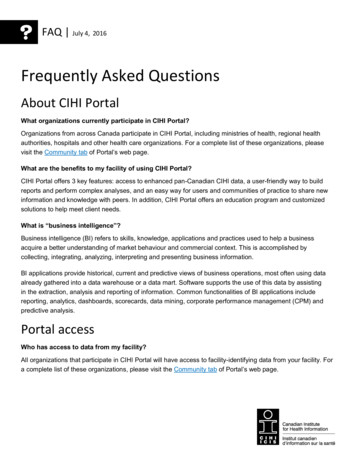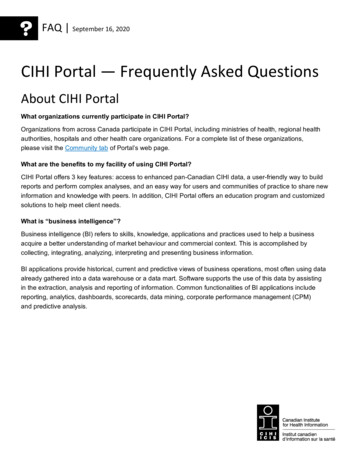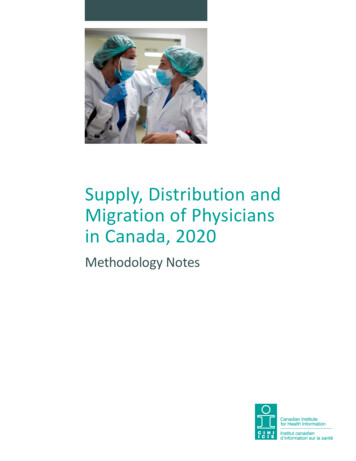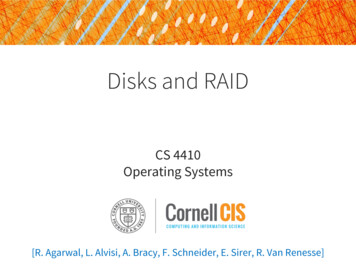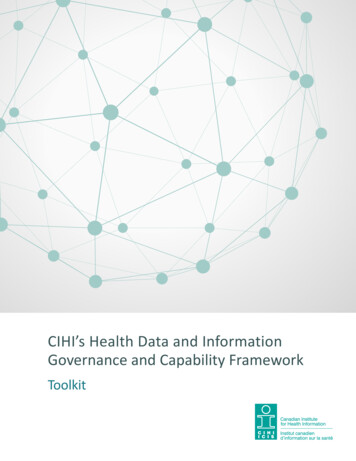
Transcription
CIHI’s Health Data and InformationGovernance and Capability FrameworkToolkit
Production of this document is made possible by financial contributions fromHealth Canada and provincial and territorial governments. The views expressedherein do not necessarily represent the views of Health Canada or any provincialor territorial government.All rights reserved.The contents of this publication may be reproduced unaltered, in whole or in partand by any means, solely for non-commercial purposes, provided that the CanadianInstitute for Health Information is properly and fully acknowledged as the copyrightowner. Any reproduction or use of this publication or its contents for any commercialpurpose requires the prior written authorization of the Canadian Institute for HealthInformation. Reproduction or use that suggests endorsement by, or affiliation with,the Canadian Institute for Health Information is prohibited.For permission or information, please contact CIHI:Canadian Institute for Health Information495 Richmond Road, Suite 600Ottawa, Ontario K2A 4H6Phone: 613-241-7860Fax: 613-241-8120cihi.cacopyright@cihi.ca 2020 Canadian Institute for Health InformationHow to cite this document:Canadian Institute for Health Information. CIHI’s Health Data and InformationGovernance and Capability Framework: Toolkit. Ottawa, ON: CIHI; 2020.Cette publication est aussi disponible en français sous le titre Cadre de renforcementdes compétences et de la gouvernance en matière de données et d’information sur lasanté de l’ICIS : trousse d’outils.
Table of contentsIntroduction . . . . . . . . . . . . . . . . . . . . . . . . . . . . . . . . . . . . . . . . . . . . . . . . . . . . . . . . . . . . . . . 4Audience, purpose and scenarios for use . . . . . . . . . . . . . . . . . . . . . . . . . . . . . . . . . . . . . 4The framework. . . . . . . . . . . . . . . . . . . . . . . . . . . . . . . . . . . . . . . . . . . . . . . . . . . . . . . . . . . . . 5Subject areas. . . . . . . . . . . . . . . . . . . . . . . . . . . . . . . . . . . . . . . . . . . . . . . . . . . . . . . . . . . 5Capability classification . . . . . . . . . . . . . . . . . . . . . . . . . . . . . . . . . . . . . . . . . . . . . . . . . . . 6Capability descriptions. . . . . . . . . . . . . . . . . . . . . . . . . . . . . . . . . . . . . . . . . . . . . . . . . . . . 6Core capabilities. . . . . . . . . . . . . . . . . . . . . . . . . . . . . . . . . . . . . . . . . . . . . . . . . . . . . . 7Foundational capabilities . . . . . . . . . . . . . . . . . . . . . . . . . . . . . . . . . . . . . . . . . . . . . . . 7Supplemental capabilities. . . . . . . . . . . . . . . . . . . . . . . . . . . . . . . . . . . . . . . . . . . . . . . 8Enabling capabilities. . . . . . . . . . . . . . . . . . . . . . . . . . . . . . . . . . . . . . . . . . . . . . . . . . . 9Assessment guides . . . . . . . . . . . . . . . . . . . . . . . . . . . . . . . . . . . . . . . . . . . . . . . . . . . . . . . . 10Network alignment assessment. . . . . . . . . . . . . . . . . . . . . . . . . . . . . . . . . . . . . . . . . . . . 10Planning phase — example. . . . . . . . . . . . . . . . . . . . . . . . . . . . . . . . . . . . . . . . . . . . . 11Execution phase — example . . . . . . . . . . . . . . . . . . . . . . . . . . . . . . . . . . . . . . . . . . . 12Actioning phase — example. . . . . . . . . . . . . . . . . . . . . . . . . . . . . . . . . . . . . . . . . . . . 13Organizational self-assessment. . . . . . . . . . . . . . . . . . . . . . . . . . . . . . . . . . . . . . . . . . . . 14Planning phase — example. . . . . . . . . . . . . . . . . . . . . . . . . . . . . . . . . . . . . . . . . . . . 15Execution phase — example . . . . . . . . . . . . . . . . . . . . . . . . . . . . . . . . . . . . . . . . . . . 16Actioning phase — example. . . . . . . . . . . . . . . . . . . . . . . . . . . . . . . . . . . . . . . . . . . . 17Appendix A: Assessment templates. . . . . . . . . . . . . . . . . . . . . . . . . . . . . . . . . . . . . . . . . . . . 18Appendix B: Health data and information (HDI) governance and capability summaries. . . . . 26
CIHI’s Health Data and Information Governance and Capability Framework: ToolkitIntroductionThis toolkit is a companion document to CIHI’s Health Data and Information Governance andCapability Framework. It includes a brief description of the 28 health data and information(HDI) capabilities, a guide for an organization’s HDI self-assessment and a network HDIalignment assessment guide. These are supported by appendices that include organizationalself-assessment and network alignment templates (Appendix A) and summaries for the HDIcore and foundational capabilities (Appendix B).Users of this toolkit can choose the type of assessment they intend to perform (networkalignment or self-assessment) and review the corresponding guide. Where appropriate,they can refer to the capability summaries for the core and foundational HDI capabilities.The complete set of capabilities is available in a supplementary toolkit on request to theCanadian Institute for Health Information (CIHI) at datagovernance@cihi.ca.Audience, purpose and scenarios for useThe audience for this document is health information organizations in Canada, suchas ministries and departments of health, health agencies and authorities, health deliveryorganizations, and health-related research organizations.This toolkit provides A guide and template for organizations to self-assess their most important HDI governanceand capabilities, envision their evolution and prioritize areas for improvement; A guide and template for networks of organizations to identify the need for and extentof alignment required of their HDI principles, practices and content, where it is beneficialtoward achieving common aims; and A common language for multi-organizational collaboration as a basis for exchange ofleading practices and lessons learned in a meaningful and constructive way that fostersimprovement and alignment.The framework and companion toolkit can be used in the following ways to support a healthinformation organization: As a checklist to avoid blind spots when considering risks, challenges or opportunities; As common language for a network of organizations to identify, prioritize and designareas where greater alignment across the network is necessary; and As a framework to articulate the necessary foundational elements to engage inadvanced data and information governance and activities such as artificial intelligence.As a tool to identify and prioritize opportunities for broad-based improvement of dataand information governance and capabilities, starting with core and foundational elements;4
CIHI’s Health Data and Information Governance and Capability Framework: ToolkitThe frameworkSubject areasAssets andstandardsData standardsAnalytical standardsIT standardsStrategyand governanceDirectionAccountabilityRisk managementAudit and complianceEngagementEducationCommunicationPeople andknowledgePolicies andprocessesData quality and stewardshipPrivacy and securityAccessPartnershipsCIHI’s Health Data and Information Governance and Capability Framework consists of 4subject areas, each with its own set of capabilities: Strategy and governance provide the overall direction, accountability and oversight for aneffective HDI program. Capabilities in this area include a clearly articulated strategy for theintended outcomes of the strategic use of HDI, governance and accountability models, andprocesses to monitor and report compliance. Policies and processes define activities for appropriate collection, processing, analysisand sharing of trusted HDI. Capabilities in this area include data management, quality,conformance, privacy, security, access and partnerships that collectively define the way theorganization operates internally and externally to ensure efficiency, effectiveness, integrityand protection. Assets and standards establish the HDI assets required by the policies and processesto enable strategic and operational outcomes. Capabilities include enterprise data assets,standards, data models and analytics insights that form the collective data foundation of theorganization or network. People and knowledge empower people, from stakeholders to the workforce, to facilitateand evolve policies, processes, designs and governance to be effective and sustained.Capabilities include engagement, education and communication both within and external tothe organization.5
CIHI’s Health Data and Information Governance and Capability Framework: ToolkitCapability classificationThe 28 capabilities in CIHI’s Health Data and Information Governance and CapabilityFramework are classified as Core: The central essence of HDI management, covering access, privacy, security,enterprise assets and engagement Foundational: Together with the core capabilities, these capabilities form a foundation forHDI activities; includes strategy, governance, risk, data standards, data model and insights Supplemental: Built on top of foundational capabilities to provide added valueand options for the organization; covers engagement, policies/processes, programmanagement and compliance Enabling: Practices/techniques that may help achieve organizational outcomesDescriptions for the capabilities are provided below. Summaries for core and foundationalcapabilities are available in Appendix B. Summaries for all capabilities — includingsupplemental and enabling — are included in the supplementary toolkit, which isavailable on request to CIHI at datagovernance@cihi.ca.Feedback on all capability summaries is appreciated so that insights can be shared amongadopters of CIHI’s Health Data and Information Governance and Capability Framework.Capability descriptionsThe following tables contain descriptions of each capability, organized by classification.The associated ID to the left of the capability relates to the subject area: SG: Strategy and governancePP: Policies and processesAS: Assets and standardsPK: People and knowledgeThese can be used to reference the summaries in Appendix B and in the supplementarytoolkit containing definitions, practices, artefacts and a rating scale for self-assessment.6
CIHI’s Health Data and Information Governance and Capability Framework: ToolkitCore capabilitiesIDCapabilityDescriptionPP1HDI privacy policies and processesPrinciples, frameworks, policies and processes for compliancewith legal and statutory privacy rules; includes legislativeauthority, governance structures, consent management,compliance, training and incident managementPP2HDI security policies and processesPrinciples, frameworks, policies and processes for securityof technology data platforms and data flows, includingaccountability and requirements, as well as data vulnerabilityand threat risk assessmentsPP3HDI access and sharing policiesand processesPrinciples, frameworks, policies and processes for access toHDI; includes data sharing and access across various types oforganizations aligned with privacy legislations, mandate andsocial licenceAS1Enterprise HDI assets catalogueand contentHDI assets under the custodianship of the organization,including the inventory and data lineage of these data assets,as well as records of incoming/outgoing data flowsPK1HDI stakeholder engagement planApproach, effort and timetable for engaging with stakeholderson the HDI roadmap, governance, policies, processes, assetsand standards, and for incorporating their perspectives onmanaging HDIFoundational capabilitiesIDCapabilityDescriptionSG1HDI roadmapStatement of vision, scope, principles and direction for theorganization to realize strategic value from HDI; includesalignment with overall organizational strategy, targets andmeasures, and high-level roadmapSG2Strategic HDI governance modelStructure of HDI governance, including internal and externalstakeholders, for strategic direction, oversight, escalation anddecision-making to ensure alignment with overall principles andHDI roadmapSG3Operational HDI governance modelAccountabilities, roles and responsibilities associatedwith HDI decision-making authorities, operational activities,education, training and relationship with governance for ITand digital programsSG4HDI risk managementFramework defining the HDI risk approach and tolerance levelof the organization, processes to assess individual risks, anddecision rights to act on the analysis; covers both negative andpositive risks and mitigation strategies to manage themAS2Enterprise data standardsSuite of data content standards that provide meaning andstructure to the organization’s data, and of data exchangestandards that simplify the flow of data between systems andenable meaningful interaction with business processes7
CIHI’s Health Data and Information Governance and Capability Framework: ToolkitIDCapabilityDescriptionAS3Enterprise data modelEnterprise-level conceptual, logical and physical models ofhealth data assets, providing a consistent and meaningful viewof the data and their interrelationships; includes diagrams,business data glossary and technical data dictionariesAS4Enterprise HDI insights practicesHealth data analytic assets of the organization as well as thesuite of analytic practices in place to provide trustworthy andethical decision support, business intelligence, indicators,algorithms and reports produced by the organizationSupplemental capabilitiesIDCapabilityDescriptionSG6HDI program managementEstablishment and operation of a cohesive, enterprisewide and ethical HDI program that sets priorities, developsand oversees HDI initiatives, orchestrates people changemanagement and reports back to executivesSG7HDI policies compliance and auditFramework for the review of compliance with legislation,policies, organization decisions, data standards, quality andprivacy rules; includes practices for monitoring, remediationand learning from compliance issuesPP4Data life cycle policies and processesPrinciples, frameworks, policies and processes for managingthe full life cycle of health data and records for their uselocally and with trusted partners; includes data collection andpreparation, linking and aggregation, and ongoing maintenancePP5Data standards policies and processesPrinciples, frameworks, policies and processes for the adoptionand deployment of data content standards, data exchangestandards, master data and associated specifications,guidelines, communication and evaluationPP6HDI quality policies and processesPrinciples, frameworks, policies and processes for assertingthe relevance, accuracy, reliability, comparability, coherence,timeliness, punctuality, accessibility and clarity of HDIPP7Data anonymization policiesand processesPrinciples, frameworks, policies and processes for theanonymization, aggregation and de-identification of datato appropriate levels, including open data; considersrisks associated with granular data for insight and risk ofprivacy breachesPP9Data change management policiesand processesPrinciples, frameworks, policies and processes for managingand coordinating changes in data and data flows within andacross systems and organizations; includes updates to coredata artefacts to retain knowledgePP10Vendor-related HDI policiesand processesPrinciples, frameworks, policies and processes for engagingwith vendors, including HDI-related procurement requirements/RFPs, data standards, protection and applicable intellectualproperty policies; articulates vendor accountability withsigned agreements8
CIHI’s Health Data and Information Governance and Capability Framework: ToolkitIDCapabilityDescriptionPP11Indigenous populations HDI policiesand processesPrinciples, frameworks, policies and processes for thetreatment of Indigenous populations HDI (First Nations, Inuitand Métis) aligned with their principles for data acquisition,storage, access and usePK2HDI internal communication planApproach, effort and timetable for communicating internallythe HDI roadmap, governance, policies, processes, assetsand standards, and for incorporating their perspectives onmanaging HDIPK3HDI workforce planApproach, supply/demand assessment and timetable formeeting the organization’s needs for HDI capacity to achieveits mandate regarding HDI management, analytics, security,privacy, etc.PK4HDI fluency programEducation curriculum, approach and modules to align targetaudience (e.g., employees, management, board) on key HDItopics including HDI management, privacy, ethics, access,advanced analytics and governanceEnabling capabilitiesIDCapabilityDescriptionSG5HDI project life cycleExtension of the standard project life cycle (e.g., softwaredevelopment, vendor software implementation) to integratewith strategic and operational accountability models for HDIPP8HDI-related intellectual property policiesand processesPrinciples, frameworks, policies and processes formanagement and recognition of HDI-related intellectualproperty, including publication rights and sharing of valueAS5Enterprise advanced analytics practicesApplication of advanced analytics practices such asmachine learning, AI and predictive analytics, and testingfor the generation of valuable insights; incorporates ethicalconsiderations associated with the generated insightsPK5HDI capability improvement programEstablishment and ongoing operation of an HDI capabilityimprovement program that includes periodic self-assessment ofcapabilities, requirements to meet upcoming business needs,gap analysis and gap closure plan9
CIHI’s Health Data and Information Governance and Capability Framework: ToolkitAssessment guidesNetwork alignment assessmentThis guide intends to help a network of health information organizations determine the needfor and extent of alignment necessary to achieve their common aims. It will help identify andprioritize opportunities to improve policies and practices within the network. The outcome ofthis assessment should provide direction for HDI governance and capability improvementefforts required among the network members, how they will work together and the ongoingoversight to make it happen.For a given capability, the network alignment level could be Standardized: Implemented the same way across all members of the network Harmonized: Implemented with a high degree of orchestration among members Coordinated: Designed as a cohesive system and implemented independently Autonomous: Implemented independently from each otherA key step in the network alignment assessment process is the identification of clearobjectives and scope of the assessment with the project sponsor(s). The assessment teammay want to consider the following guidelines to help achieve desired outcomes: Objectives: The team specifies the overarching objectives for the network alignmentassessment and desired outcomes. Scope of the assessment:– HDI governance and capabilities: The team decides which capabilities to includewithin the scope of the assessment, based on the specified objectives. Depending on thecapacity of the network and project team, a suitable starting place could be to focus ononly core or core and foundational capabilities.– Member organizations: The team decides which network members would be requestedto participate in the assessment. Expertise: The team should have the level of expertise required to carry out the networkassessment based on the specified objectives and scope. The project lead should be fluentin HDI and familiar with the network organizations.10
CIHI’s Health Data and Information Governance and Capability Framework: Toolkit Network alignment level assignment: The team decides how they will assess the networkalignment level of a given HDI capability, and whether they will specify the overall alignmentlevel for that capability or provide more granularity. For example, within an assessmentof privacy policies and processes, privacy impact assessment (PIA) templates may beassessed as being “standardized,” whereas PIA processes may be assessed as being“coordinated” across the network.A template for capturing the information during the assessment is available in Appendix A.The information below provides a detailed example of the planning, execution and actioningphases of the assessment process.Planning phase — exampleObjectiveTo develop and seek approval for the HDI network alignment assessment project terms of referenceand associated project plan, participants and resourcesInput Sponsor (executive or director level) for HDI network alignment assessment Project lead for HDI network alignment assessment Previous HDI network alignment assessment (if available)Process1. Hold a meeting of sponsor and project lead to determine HDI network alignment assessmentproject terms of reference covering Objectives of the HDI network alignment assessment project Scope of the assessment (member organizations, HDI capabilities) Assumptions and constraints (e.g., depth of assessment, deadlines) Assessment facilitator(s) and participants Overall approach to assessment (e.g., workshop[s], 1:1 interviews) Report back and follow-ups2. Draft HDI network alignment assessment project terms of reference based onmeeting outcomes.3. Review project terms of reference with sponsor.4. Prepare detailed project plan (work breakdown structure [WBS], timetable, participants, etc.).5. Seek approval of HDI network alignment assessment project plan by sponsor.OutputAdditionalguidelines Approved HDI network alignment assessment project terms of reference Approved HDI network alignment assessment project plan and budget Confirmed HDI network alignment assessment facilitator(s) and participants Scope: An initial assessment may cover a subset of the capabilities (e.g., only core andfoundational capabilities). Process: Conducting the assessment as a group facilitation may be more effective to have themembers hear each other’s perspective and come to consensus. Participants: Generally, leaders within the member organizations who have both a deepunderstanding of their organization and a perspective on the outcomes of the network.11
CIHI’s Health Data and Information Governance and Capability Framework: ToolkitExecution phase — exampleObjectiveTo perform the HDI network alignment assessment project plan in order to profile the network’salignment level for each of the in-scope HDI capabilities and their importance to the networkInput Approved HDI network alignment assessment project terms of reference, plan andProcessassociated budget Confirmed HDI network alignment assessment facilitator(s) and participants Network organizations business plan and/or strategy1. Schedule workshop(s) and/or 1:1 interviews based on HDI network alignmentassessment project plan.2. Conduct workshop(s) and/or interviews, using the HDI network alignment assessmenttemplate row by row or classification by classification, and determine Business importance to the network (minimal/none, useful, necessary, essential) Alignment level (standardized, harmonized, coordinated, autonomous) Notes/action items associated with the assessment of this HDI network capability(e.g., details on which processes could be harmonized, which organizationcould lead the item)3. Consolidate action items resulting from the assessment session(s).4. Circulate draft assessment results and action items to workshop participants foradditional feedback.5. Finalize HDI network alignment assessment results and action items and send to participants.Output Validated HDI network alignment assessment List of organizations that could lead standardization or harmonization as identified during theassessment to achieve target stateAdditionalguidelines Network’s business plan of strategy: Can be used to assess importance for the network forthis HDI capability Business importance level: Degree the network depends on this HDI capability in order to fulfillits mandate, meet its obligations, execute its strategic priorities and manage its operations Alignment level: In the comments, include the level for different types of artefacts (e.g.,standardize principles, harmonize policies, coordinate processes)12
CIHI’s Health Data and Information Governance and Capability Framework: ToolkitActioning phase — exampleObjectiveTo address the action items identified during the HDI network alignment assessment’s interviews/workshops, prepare the assessment report and recommendations for sponsor’s approval, andcommunicate outcomes to networkInput Completed HDI network alignment assessment template reviewed by participants List of potential members to lead standardization or harmonization of capability in the networkProcess1. Summarize potential leads for standardization or harmonization activities and identify areas ofoverlap (multiple members on 1 capability) or underlap (no members identified).2. Prepare recommendation for potential.3. Prepare communication plan and associated materials.4. Review HDI network alignment assessment report, including communications, with sponsor.5. Present report highlights, conclusions and recommendations to senior management acrossnetwork for their approval.6. Execute HDI network alignment assessment communication plan.OutputAdditionalguidelines Approved HDI network alignment assessment and communication plan HDI network alignment assessment outcomes communicated within the networkHDI network alignment assessment report should include Executive summary Assessment facilitator(s) and participants Objectives, scope and approach to assessment Assumptions and constraints Assessment results for each capability with rationale Conclusions arising from assessment Lessons learned for next assessment cycle Communication strategy13
CIHI’s Health Data and Information Governance and Capability Framework: ToolkitOrganizational self-assessmentThis guide intends to help a health information organization perform a self-assessment of itsHDI governance and capabilities. It will help to identify and prioritize opportunities to improvepolicies, practices and artefacts within the organization and demonstrate progress in theorganization’s evolution.A key step in the self-assessment process is the identification of clear objectives and scopewith the project sponsor. In this step, the assessment team may want to consider the followingguidelines to help achieve the desired outcomes: Objective: The team decides the overarching objectives of the project, a time frame for thetarget state and overall desired outcomes. Time frame: The team decides the time frame for the desired target state and desiredoutcomes. The time frame can be self-imposed, based on available funding or based on thetime period of an overarching strategic plan for the organization. For example, an objectivecould be to enable artificial intelligence in the organization within 2 years, or to improvetrust and reliability in organizational outputs by strengthening the organization’s datafoundation within 1 year. Scope of the assessment:– HDI assets: The team decides which HDI assets to include in the assessment in orderto achieve the desired outcomes. For example, the organization may wish to focus onassets of highest significance to stakeholders.– HDI capabilities: The team decides which capabilities to include in the scope of thereview. This will be based on the objectives and HDI data asset scope. Depending on thecapacity of the organization and project team, a suitable starting place could be to focuson only core or core and foundational capabilities. Expertise: The team should have the level of expertise required to take on the assessmentbased on the objective and the scope of the assessment. The project lead should be fluentin HDI and also familiar with the organization. Capability level assignment: The team decides whether they are going to presenttheir assessment of a given HDI capability level as an “average” or “worst case” acrossthe HDI assets within scope. For example, if 1 asset in scope doesn’t have a datadictionary defined, does it mean that the overall capability is “basic” (worst case)? Or ifthe majority of assets are catalogued and defined, then the overall capability could be“proficient” (average). Formality level: The team should decide how formal the process will be, given theobjective. An informal process may be appropriate for an initial assessment to provide ageneral idea of the capability level and areas of immediate priority. A more formal processmay be important if preparing for an audit or policy compliance review. Depending on thesituation, some of the in-scope capabilities could be reviewed formally and others informally.14
CIHI’s Health Data and Information Governance and Capability Framework: ToolkitA template for capturing the information during the assessment is available in Appendix A.The information below provides a detailed example of the planning, execution and actioningphases of the assessment process.Planning phase — exampleObjectiveTo develop and seek approval for the HDI self-assessment project terms of reference andassociated project plan, participants and resourcesInput Sponsor (executive or director level) for HDI self-assessment Project lead for HDI self-assessment HDI network alignment assessment (if available) Previous HDI self-assessment (if available) Previous HDI target state roadmap (if available)Process1. Hold a meeting (sponsor and project lead) to determine HDI self-assessment project terms ofreference covering Objectives of the HDI self-assessment project Scope of the assessment (organization units, HDI capabilities, data assets) Assumptions and constraints (e.g., depth of assessment, deadlines) Assessment facilitator(s) and participants Overall approach to assessment (e.g., workshop[s], 1:1 interviews) Report back and follow-ups2. Draft HDI self-assessment project terms of reference based on meeting outcomes.3. Review project terms of reference with sponsor.4. Prepare de
CIHI's Health Data and Information Governance and Capability Framework: Toolkit. Capability classification. The 28 capabilities in CIHI's Health Data and Information Governance and Capability Framework are classified as Core: The central essence of HDI management, covering access, privacy, security, enterprise assets and engagement
